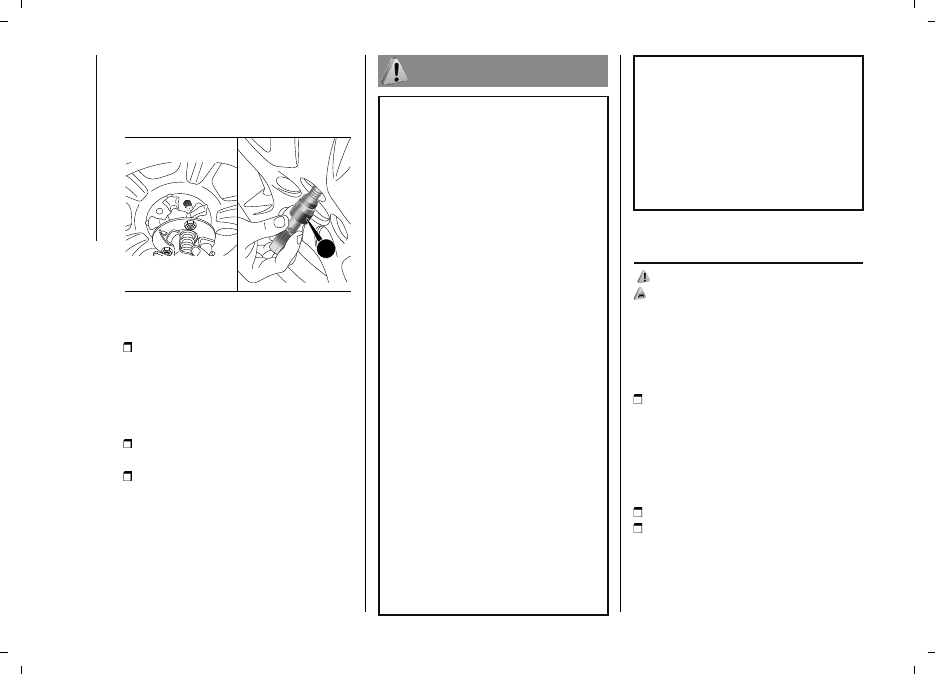Fiat Doblo Panorama (2019 year). Manual - part 9

IN AN EMERGENCY
138
fix the wheel to the adaptor, using the
socket wrench for the wheel nuts (G)
fig. 194.
Tighten the screws with the wheel
removal wrench.
G
194
F0V0216
NOTE Use the spare wheel covering
bag to protect the replaced alloy wheel.
check that the position of the
replaced wheel under the platform is
correct (the lifting system is equipped
with a clutch to limit the end of the
stroke, incorrect positioning may
jeopardise safety);
put the jack and the tools back in the
dedicated tool bag;
reposition the tool bag behind the left
side seat (Cargo versions) or, resting
the bottom of the bag against the side
panel, in the compartment inside the
rear right side (Doblò/Doblò Combi
versions).
WARNING
122)
The space-saver wheel (for
versions/markets, where provided) is
specific to your vehicle, do not use it on
other models, or use the space-saver
wheel of other models on your vehicle. The
space-saver wheel must only be used in
the event of an emergency. Never use it
for more than strictly necessary and never
exceed 80 km/h. Important! For temporary
use only! 80km/h max! Replace with
standard wheel as soon as possible.
Never remove or cover the sticker on
the space-saver wheel. Never apply a
wheel cap on a space-saver wheel. The
driving characteristics of the vehicle will be
modified with the space-saver wheel fitted.
Avoid violent acceleration and braking,
abrupt steering and fast cornering.
123)
Use your hazard lights, warning
triangle, etc to show that your vehicle is
stationary. Passengers should get out
of the vehicle, particularly if it is heavily
loaded, and wait for the wheel to be
changed away from the traffic. If you
are on a slope or uneven surface, place
wedges or other suitable objects under
the wheels to secure the vehicle. Have
the wheel repaired and refitted as soon as
possible. Do not apply grease to the bolt
threads before fitting: they could come
unscrewed.
124)
Use the jack only to replace wheels
on the vehicle with which it is supplied
or on other vehicles of the same model.
Never use the jack for other purposes,
such as lifting other models. Never use the
jack to carry out repairs under the vehicle.
Incorrect positioning of the jack may cause
the lifted vehicle to fall. Do not use the jack
for loads higher than the one shown on its
label.
125)
Incorrect hub cap assembly may
cause it to come off when the vehicle is
moving. Never tamper with the inflation
valve. Never introduce tools of any kind
between rim and tyre. Check tyre and
space-saver wheel pressures regularly,
complying with the values given in the
"Technical specifications" chapter.
FIX&GO AUTOMATIC
KIT
126) 127)
43)
DESCRIPTION
The Fix&Go quick tyre repair kit
fig. 195 is located in the boot, inside a
dedicated container and consists of:
one cartridge (1) containing sealant
and fitted with: transparent tube for
injecting the sealant (4) and sticker (3)
with the wording "Max. 80 km/h" to be
placed in a clearly visible position (e.g.
on the dashboard) after repairing the
tyre;
one compressor (2);
one leaflet containing instructions for
using the kit;